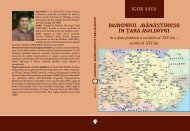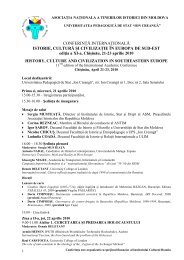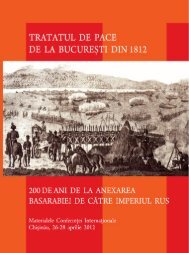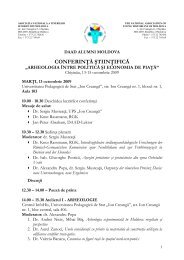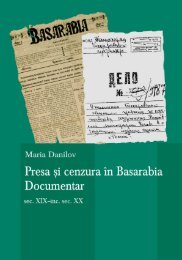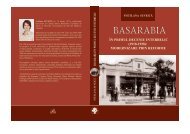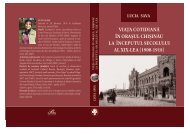Publicatie cu continut integral - Asociatia Tinerilor Istorici din Moldova
Publicatie cu continut integral - Asociatia Tinerilor Istorici din Moldova
Publicatie cu continut integral - Asociatia Tinerilor Istorici din Moldova
You also want an ePaper? Increase the reach of your titles
YUMPU automatically turns print PDFs into web optimized ePapers that Google loves.
aBStRaCt<br />
On September 22, 1990, in Moscow, <strong>Moldova</strong>n President Mircea Snegur and the Russian homologue – Boris<br />
Eltsyn signed the Treaty on interstate relations between Federative Soviet Socialist Republic of Russia and Soviet<br />
Socialist Republic of <strong>Moldova</strong>, treaty containing 23 articles of a epocal importance.<br />
This treaty was fulfilling to establish a favorable political and economic conditions between the High Parties,<br />
development of friendship and cooperation relations accor<strong>din</strong>g to international law. The High Parties declared to<br />
respect which other’s sovereignty, naot to attent to the rights of which other. Also, the treaty declared to establish<br />
a mutual equality based relations between the High Parties.<br />
On October, 1 of 1990, the <strong>Moldova</strong>n Parliament ratified the treaty almost unanimous,. Russian authorities,<br />
due to Transnistria Region events of 1990 was not ratified the treaty, transforming, thereby, the treaty into a mean<br />
of political and strategic pressure on Kishinev Government. Moreover, after involving of Russian 14 th army in<br />
Transnistria military conflict of 1992, the question of ratifying this treaty, as well as normalizing bilateral relations<br />
wasn’t a priority of both Governments.<br />
A very important problem of bilateral relations constitutes the withdraw of Russian 14 th army, transformed in<br />
1992 in Peace Corps in Transnistria Region of <strong>Moldova</strong>. The Convention of October, 21 of 1994 stipulated the<br />
obligation of Russian part to withdraw it’s army in a delay of three years from the date of signing. Unfortunately,<br />
until present, the Russian 14 th army is located, although reduced as military and human potential, in Transnistria<br />
Region. <strong>Moldova</strong> rest, a country with great se<strong>cu</strong>rity and political problems especially from this point of view.<br />
Despite the basic misunderstan<strong>din</strong>gs between <strong>Moldova</strong> and Russia, in 1995-1999 the bilateral relations were<br />
determined by stability and constructive political development, accor<strong>din</strong>g to that period Russian Ambassador in<br />
<strong>Moldova</strong> – Alexandr Papkin. At this time both Russia and <strong>Moldova</strong> were decided to sign in 2000 a new Treaty on<br />
bilateral relations, without any reference to 14 th army withdraw from <strong>Moldova</strong>. Moreover, in the early 2000 years<br />
Russia, based on the political of <strong>Moldova</strong>n Communist Party-government party from 2001, was attempted to<br />
regulate the Transnistria problem by the famous Kozak memorandum , proposed to <strong>Moldova</strong>n authorities in 2003<br />
with reference to a future <strong>Moldova</strong> as a two-part federative state, represented by two equal subjects: Transnistria<br />
and <strong>Moldova</strong>, without any reference to 14 th army withdraw, no guaranties of <strong>Moldova</strong> integrity in the future. As<br />
result, <strong>Moldova</strong>n President – V. Voronin, rejected this plan, starting from 2003 the bilateral relations between <strong>Moldova</strong><br />
and Russia are in a very diffi<strong>cu</strong>lt period, <strong>Moldova</strong> being now interested more in ensuring it’s own integrity<br />
and stability than to maintain some kind of privileged relations with Russia.<br />
Bıblıografıe<br />
1. “Arena Politicii”, Chişinău, nr.6, 1996.<br />
2. “Sfatul Ţării”, nr.239, 1991.<br />
3. “<strong>Moldova</strong> Suverană”, nr.225, 1990.<br />
4. “<strong>Moldova</strong> Suverană”, nr.280, 1990<br />
5. “<strong>Moldova</strong> Suverană”, nr. 229, 230, 1990.<br />
6. “<strong>Moldova</strong> Suverană”, nr. 230, 1990.<br />
7. “<strong>Moldova</strong> Suverană”, nr.232, 1990.<br />
8. “<strong>Moldova</strong> Suverană”, nr.144, 1991.<br />
9. “<strong>Moldova</strong> Suverană”, nr.168, 1991.<br />
10. “<strong>Moldova</strong> Suverană”, nr.167, 1991.<br />
11. “Adevărul”, nr.626, 1992.<br />
12. “Adevărul”, nr.657, 1992.<br />
13. GRIBINCEAÖ M., 1998, Trupele ruse în Republica <strong>Moldova</strong>: factor stabilizator sau sursă de pericol?, Chişinău.<br />
14. Memorandumul privind principiile de normalizare a relaţiilor între Republica <strong>Moldova</strong> şi Transnistria, în “Arena Politicii”,<br />
Chişinău, nr.8 , 1997.<br />
15. Agenţia de presa FLUX, 1997, 29 octombrie.<br />
16. GRIBINCEAÖ M., 1999, Politica rusă a bazelor militare: Georgia şi <strong>Moldova</strong>, Chişinău, 45.<br />
17. LUČINSKIJÖ P., 2001, est’ perspektiva stat’ normal’noj stranoj so svoej specifikoj în “Meždunarodnaja Žizn’”, II, 88-91.<br />
18. COJOCARUÖ Gh. 2001, Politica externă a Republicii <strong>Moldova</strong>, Chişinău.<br />
© Pavel RÎşNeANU, 2008<br />
– –



